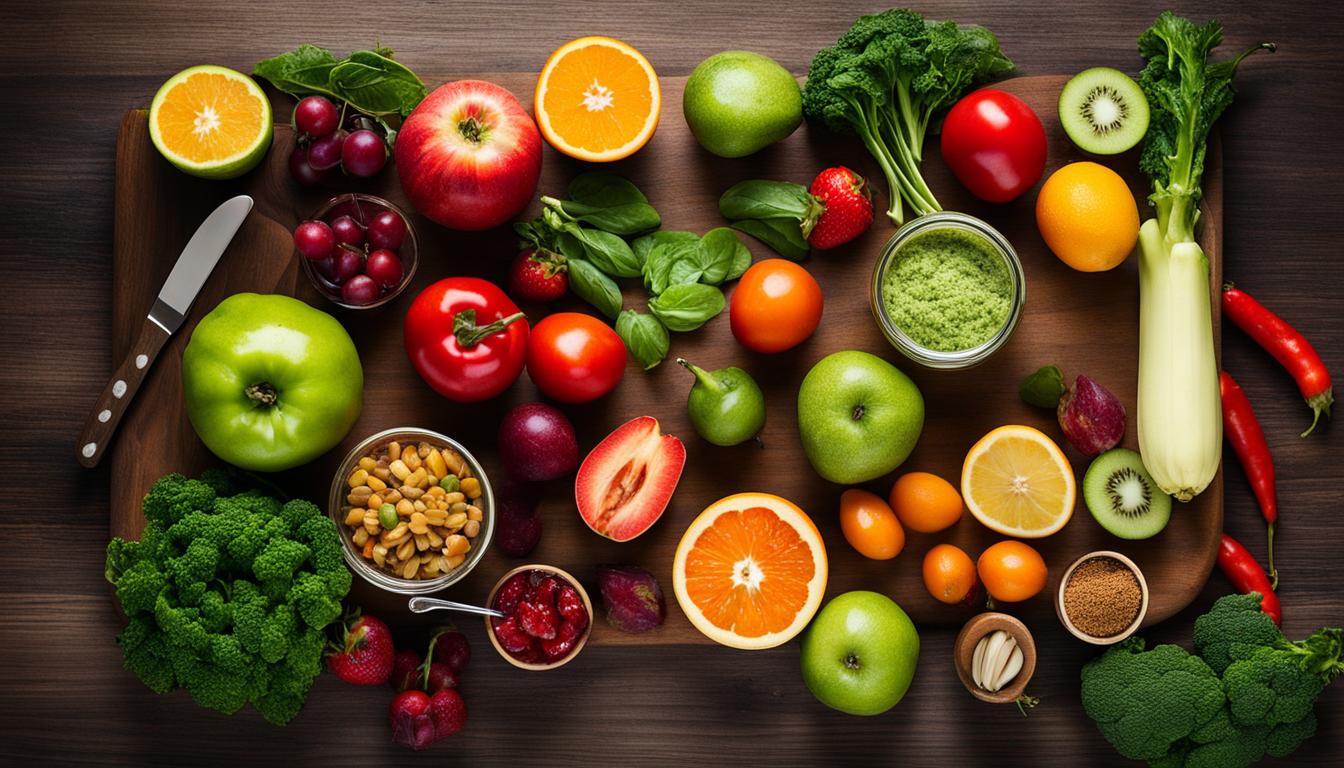Maintaining a healthy diet is crucial, even when life gets busy. However, finding the time to plan and prepare nutritious meals can seem overwhelming. In this article, we’ll provide you with practical tips and strategies to help you master healthy meal planning and effortlessly incorporate balanced meals into your busy schedule.
Whether you’re a working professional, a busy parent, or both, our guide will equip you with the knowledge and tools to make quick, delicious recipes that prioritize your health. With smart preparation techniques and simple time-saving hacks, you’ll be well on your way to enjoying nutritious, home-cooked meals every day.
Key Takeaways
- Plan your meals ahead of time to save time and make healthier choices.
- Select nutrient-dense foods like fresh fruits, vegetables, lean proteins, and whole grains.
- Pack portable snacks to avoid unhealthy snacking when on the go.
- Start your day with a balanced breakfast to kickstart your metabolism.
- Stay hydrated throughout the day by carrying a reusable water bottle.
Plan Ahead for Healthy Eating
When it comes to maintaining a healthy diet, preparation is key. By setting aside some time each week to plan your meals and snacks, you can ensure that you have nutritious options available even on your busiest days. Meal planning not only saves time and effort but also helps you make healthier choices. Here are some meal planning tips to get you started:
1. Create a Meal Plan
An effective meal plan acts as your road map for the week. Take a few minutes to sit down and decide what meals you want to have each day. Consider your dietary needs, preferences, and any specific goals you have, such as incorporating more plant-based meals or reducing your intake of processed foods. Planning your meals in advance allows you to make more conscious choices and avoid impulsive, unhealthy options.
2. Make a Shopping List
Once you have your meal plan, create a shopping list to ensure you have all the necessary ingredients on hand. Planning your grocery shopping not only saves time but also helps you avoid unnecessary purchases and reduces food waste. Write down all the items you will need for your planned meals and snacks, and stick to your list when you visit the grocery store.
3. Batch-Cook Healthy Staples
Batch-cooking is a fantastic time-saving technique that allows you to have pre-made meals or ingredients ready to go. Choose a day or two each week to prepare larger quantities of healthy staples like grains, proteins, and vegetables. Cook a big pot of quinoa, roast some chicken breasts, or steam a variety of vegetables. Divide them into individual portions and store them in the fridge or freezer. This way, you can easily assemble a balanced meal by combining these pre-cooked ingredients with fresh produce or additional seasonings.
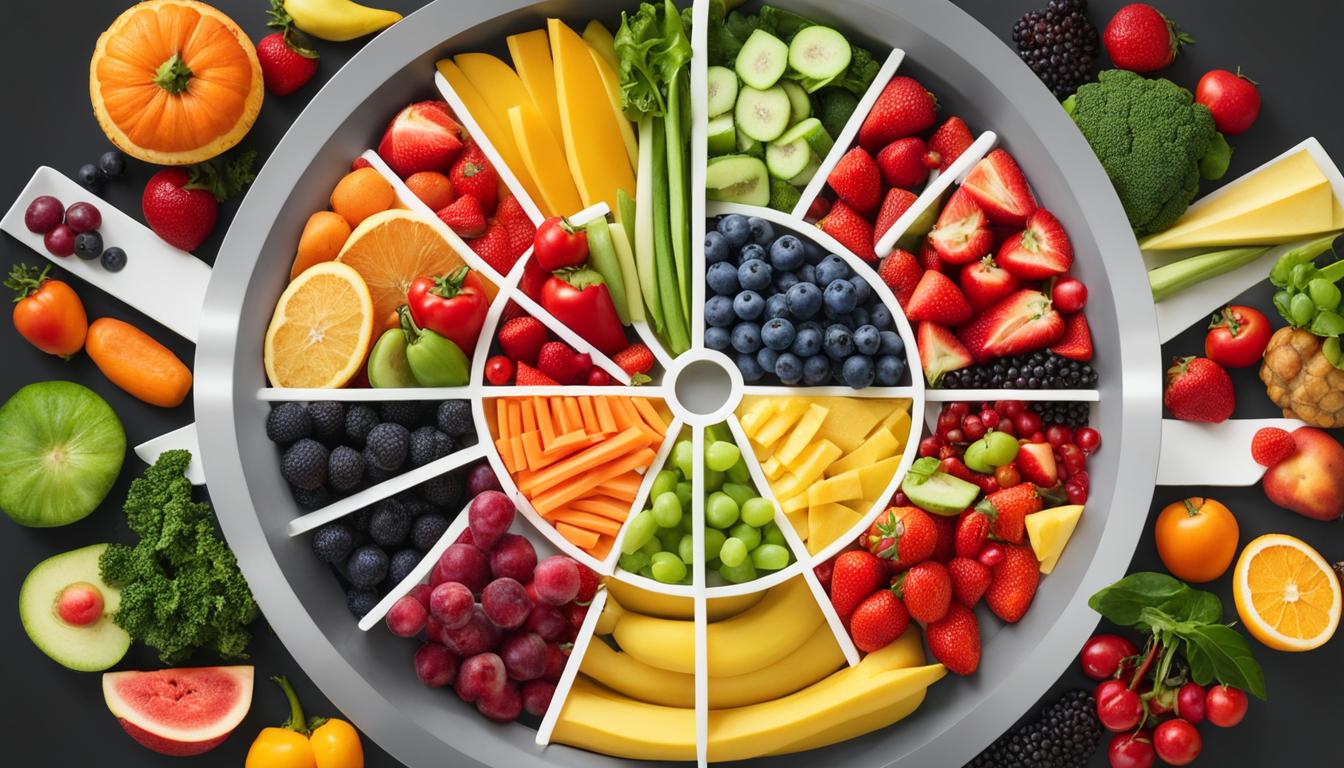
By following these meal planning tips, you can take control of your eating habits and ensure that you always have healthy options readily available. Whether you have a busy schedule or simply want to make more mindful choices, planning ahead can make all the difference in achieving your nutrition goals.
Choose Nutrient-Dense Foods
When it comes to maintaining a healthy diet, it’s important to choose foods that are packed with nutrients and provide the nourishment your body needs. Opting for nutrient-dense options ensures that you are getting the most bang for your buck in terms of the vitamins, minerals, and other beneficial compounds they contain.
Include a variety of fresh fruits and vegetables in your daily meals. These colorful and flavorful options provide essential vitamins, minerals, and antioxidants that support overall health. Incorporate lean proteins such as chicken and fish, which supply essential amino acids for muscle repair and growth.
Don’t forget to include whole grains in your diet. Quinoa and brown rice are excellent choices as they offer fiber, B vitamins, and minerals like magnesium and selenium. Healthy fats are also an important part of a balanced diet. Avocados and nuts provide monounsaturated fats that are heart-healthy and help with the absorption of fat-soluble vitamins.
“Choosing nutrient-dense foods such as fresh fruits and vegetables, lean proteins, whole grains, and healthy fats is a smart way to fuel your body with essential nutrients while managing your calorie intake.”
By making these choices, you ensure that your body is well-nourished and energized throughout the day. Remember, healthy eating doesn’t have to be dull or restrictive; it can be a delicious and fulfilling experience!
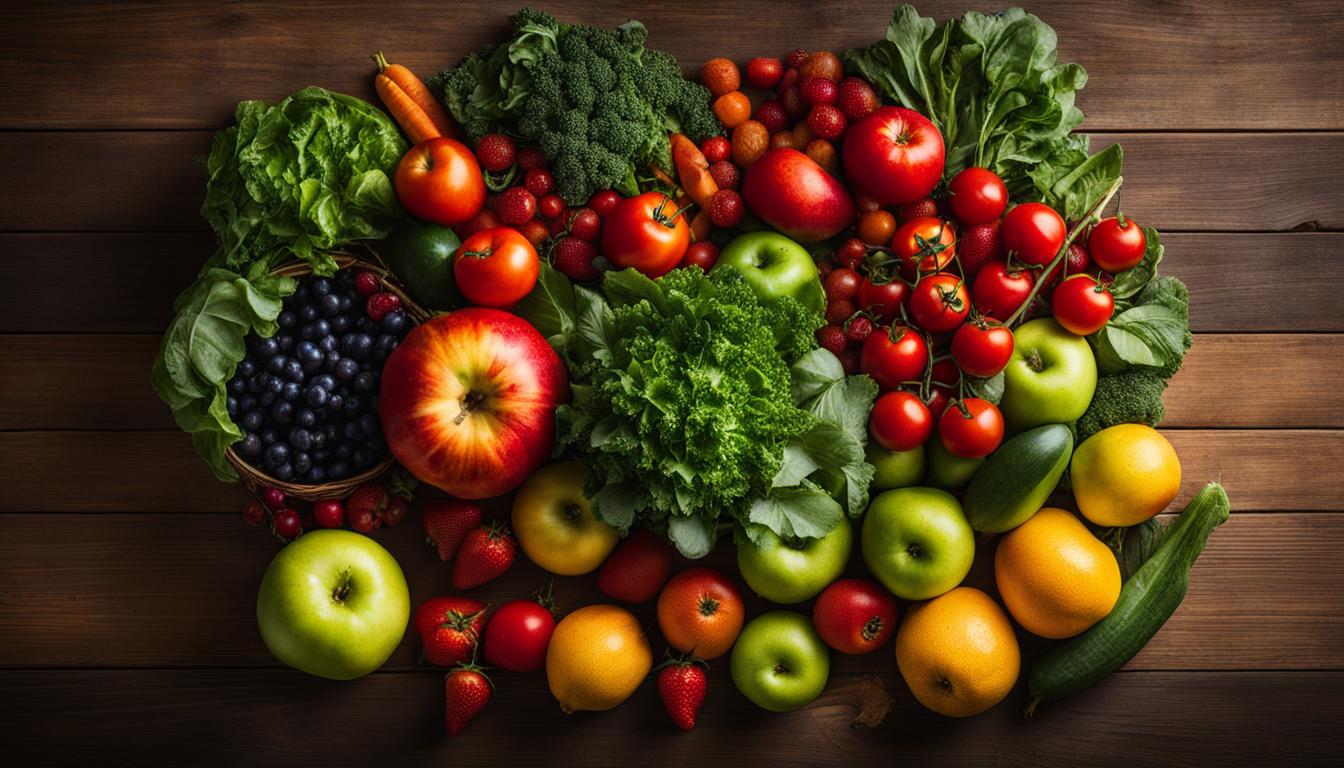
Pack Portable Snacks
When you’re on the go, it can be easy to reach for unhealthy snacks that are full of empty calories. But with a little planning, you can enjoy convenient and nutritious options to satisfy your cravings. Packing portable snacks ensures you have a healthy alternative to keep you fueled throughout the day.
Trail Mix: A Nutrient-Packed Powerhouse
Trail mix is a go-to option for a healthy snack on the move. Packed with a blend of nuts, seeds, dried fruits, and sometimes a touch of sweetness, trail mix provides a balance of protein, fiber, and healthy fats. It’s a great choice to keep you satiated and energized throughout the day.
Greek Yogurt: Creamy and Protein-Packed
Greek yogurt is a portable and protein-rich snack that can be enjoyed anywhere. With its creamy texture and tangy taste, it’s a satisfying option that keeps you full and supports muscle recovery. Pack a single-serving container with your favorite toppings like fresh berries or granola for added flavor and nutrients.
Whole-Grain Crackers: A Crunchy and Wholesome Choice
Swap out empty-calorie chips for whole-grain crackers as a healthier snacking option. Rich in fiber and complex carbohydrates, they provide sustained energy and keep you feeling satisfied. Pair them with a side of hummus or your favorite nut butter for a delicious and nutritious snack.
Sliced Fruits and Vegetables: Nature’s Perfect Snacks
Nothing beats the freshness and natural goodness of sliced fruits and vegetables. Carrot sticks, celery, cucumber, apple slices, and grapes are just a few examples of portable produce that provide essential vitamins, minerals, and antioxidants. Pack them in a container or zip-top bag for a refreshing and low-calorie snack.
To create a balanced and satisfying snack, mix and match these options based on your taste preferences and dietary needs. Don’t forget to drink plenty of water to stay hydrated throughout the day!
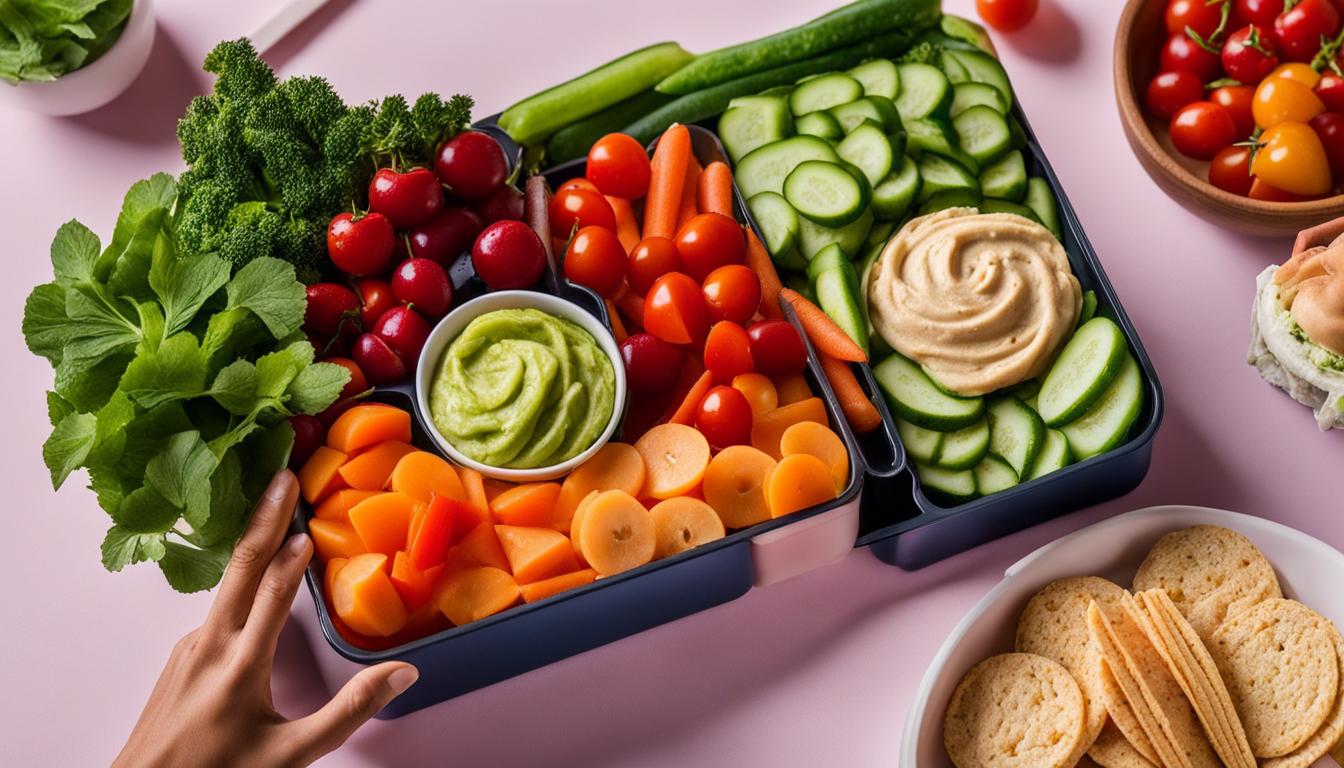
Don’t Skip Breakfast
Starting your day with a balanced breakfast is crucial for maintaining energy levels and overall well-being. A well-rounded breakfast should include protein, fiber, and healthy fats to keep you fueled throughout the morning. Here are some quick and nutritious options to consider:
Overnight Oats
Image of Overnight Oats
One convenient and delicious breakfast option is overnight oats. These are made by combining rolled oats with a liquid of your choice, such as milk or yogurt, and leaving them to soak overnight. In the morning, you can top them with fresh fruits, nuts, or seeds for added flavor and nutritional value.
Smoothies
Image of Smoothie
Another quick and satisfying breakfast option is a smoothie. Blend together your favorite fruits, vegetables, and a source of protein such as Greek yogurt or protein powder. You can also add in some greens, like spinach or kale, for an extra boost of nutrients.
Whole-Grain Toast with Peanut Butter
Image of Whole-Grain Toast with Peanut Butter
If you prefer a savory option, consider having whole-grain toast with a spread of peanut butter. This combination provides a good balance of carbohydrates, healthy fats, and protein. You can also add sliced bananas or berries on top for some added sweetness.
Remember, breakfast is the most important meal of the day, and skipping it can lead to low energy levels and unhealthy snacking later on. So, make it a priority to start your day with a balanced breakfast to kickstart your metabolism and provide the nutrients your body needs.
Stay Hydrated
Proper hydration is essential for maintaining a healthy lifestyle. One simple way to stay hydrated throughout the day is by carrying a reusable water bottle and drinking water regularly. Not only does this help quench thirst, but it also reduces the temptation to reach for sugary drinks that can negatively impact your health.
In addition to water, you can add variety to your hydration routine by incorporating herbal teas into your daily routine. Herbal teas offer a range of flavors and health benefits, making them a refreshing alternative to plain water. Whether you enjoy a soothing cup of chamomile or a revitalizing blend of peppermint, these natural beverages provide a hydrating experience with added therapeutic advantages.
For a burst of flavor, try infusing your water with slices of fruit or cucumber. Infused water not only tastes delicious but also provides natural hydration coupled with the nutrients and antioxidants from the ingredients. Whether you’re using lemon slices for a tangy twist or cucumber slices for a refreshing boost, infused water allows you to enjoy a flavorful and hydrating beverage.
Remember, proper hydration is key to maintaining optimal health and well-being. By staying hydrated with a reusable water bottle, incorporating herbal teas, and enjoying infused water, you can ensure your body receives the hydration it needs to function at its best.

Stay hydrated with a reusable water bottle and enjoy the refreshing flavors of herbal teas and infused water.
Use Time-Saving Kitchen Tools
When it comes to preparing healthy meals with minimal effort, investing in time-saving kitchen gadgets can be a game-changer. Kitchen tools like a slow cooker, pressure cooker, and food processor are fantastic additions to any busy cook’s arsenal.
The slow cooker is a versatile appliance that allows you to create delicious, slow-cooked meals with minimal hands-on time. Simply throw in your ingredients in the morning, set the temperature, and let it work its magic throughout the day. By the time you come home from work, a warm and comforting meal will be waiting for you.
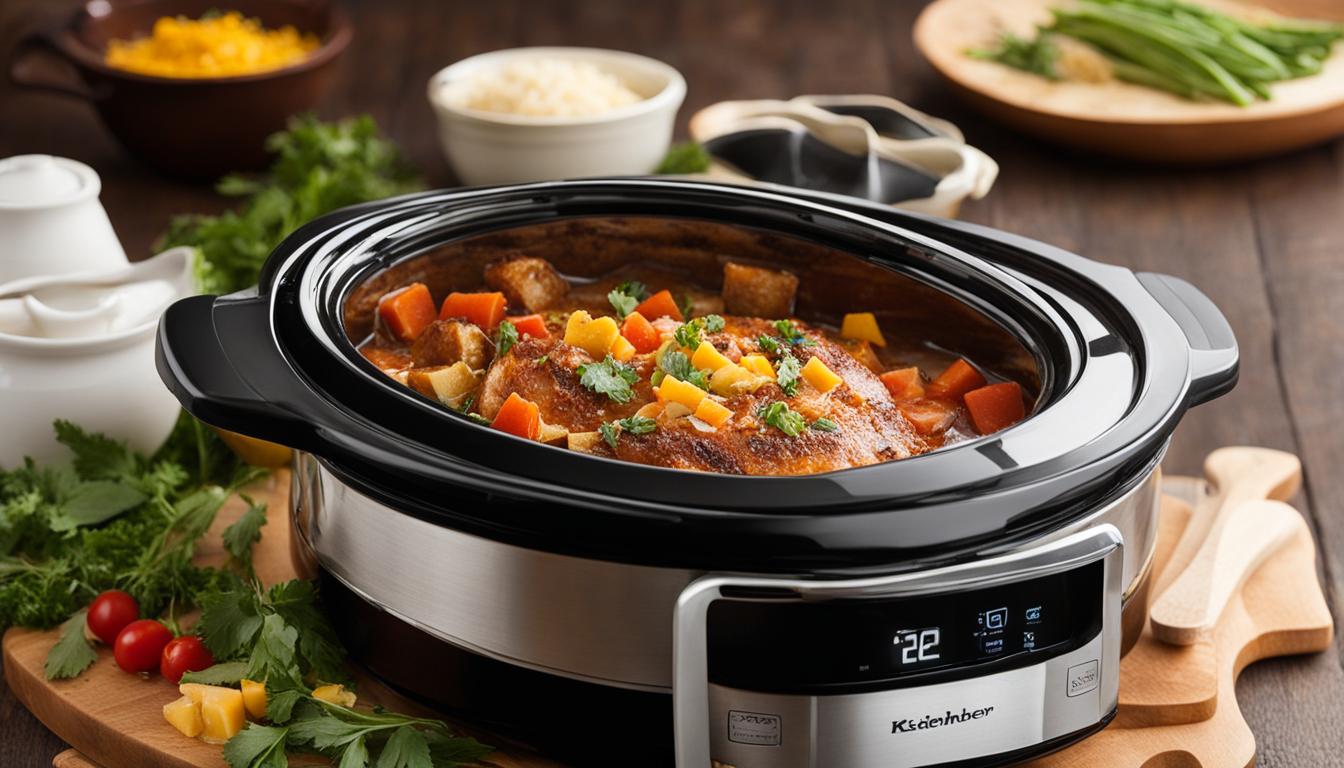
If you’re looking to slash cooking time even further, consider adding a pressure cooker to your kitchen repertoire. With its ability to cook food quickly under high pressure, a pressure cooker can turn tough cuts of meat into tender and flavorful dishes in a fraction of the time needed for traditional cooking methods.
Need to chop, slice, or dice ingredients in a flash? A food processor is the perfect tool for the job. Whether you’re preparing salsas, pestos, or mixing dough, a food processor can save you precious time in the kitchen and simplify your meal preparation process.
Time-saving kitchen tools like the slow cooker, pressure cooker, and food processor can help streamline your cooking process, allowing you to enjoy healthy and delicious meals without sacrificing hours in the kitchen.
Mindful Eating
When it comes to maintaining a healthy diet, the way you eat plays a crucial role. Mindful eating is a practice that encourages you to pay full attention to your mealtime experience, allowing you to savor the flavors, appreciate the nourishment, and make conscious choices about what you put into your body.
One key aspect of mindful eating is avoiding distractions. In today’s fast-paced world, it’s easy to get caught up in multitasking or scrolling through your phone while eating. However, by focusing solely on your meal, you can better tune in to your body’s hunger and fullness cues, leading to more balanced food choices and enhanced satisfaction.
Eating slowly is another important component of mindful eating. By taking the time to chew your food thoroughly and savor each bite, you not only enhance your digestion but also allow your brain to register the physical sensations of fullness. This can prevent overeating and promote more mindful portion sizes.
Recognizing fullness is a skill that can be developed through intentional practice. As you eat, periodically check in with yourself to gauge your level of satisfaction. Are you still hungry or comfortably full? This awareness can help you make more conscious decisions about when to stop eating, promoting a healthier relationship with food.
Mindful eating is not about rigid rules or strict diets. It’s an invitation to bring awareness and presence to your meals, allowing you to enjoy the experience and nourish your body and mind. By embracing mindful eating, you can cultivate a deeper connection with your food and foster a healthier, more balanced lifestyle.
Healthy Takeout and Restaurant Options
When it comes to eating out or ordering takeout, finding healthy options can sometimes be a challenge. However, with a little knowledge and strategy, you can make informed and healthier choices even when dining away from home.
One key tip is to look for restaurants that offer a variety of healthy options on their menu. Many establishments now provide nutrition information alongside their dishes, allowing you to make choices based on your dietary preferences or requirements. This information can help you select meals that align with your health and wellness goals.
When perusing the menu, consider opting for salads as they are often packed with fresh vegetables and provide an excellent source of vitamins and minerals. To make the salad more filling, add lean proteins like grilled chicken, turkey, or tofu. These proteins will not only satisfy your hunger but also contribute to a balanced meal.
Another way to make healthier choices is by selecting items that are prepared using grilling or steaming methods. Grilled or steamed proteins, such as fish or chicken, are lower in unhealthy fats and calories compared to dishes that are fried or coated in heavy sauces. By choosing these preparation methods, you can enjoy flavorful meals while keeping your nutritional intake in check.
“When eating out or ordering takeout, focus on choosing salads with lean proteins and opt for dishes that are grilled or steamed. These options provide nutrition while being mindful of calories and unhealthy ingredients.”
Next time you’re dining out or grabbing takeout, keep these tips in mind to make healthier choices. Remember, it’s possible to enjoy a delicious meal while still prioritizing your health and nutrition goals.

Tasty and nutritious salads
Salads are a versatile option that allows for creativity and customization. They can feature a variety of vegetables, fruits, and toppings to provide a range of flavors and textures. Here are a few salad ideas to inspire your healthy dining choices:
- Grilled chicken Caesar salad with fresh romaine lettuce, creamy Caesar dressing, Parmesan cheese, and whole-wheat croutons.
- Asian-inspired salad with mixed greens, grilled shrimp, mandarin oranges, crunchy almonds, and a tangy sesame dressing.
- Mediterranean salad with mixed greens, cherry tomatoes, cucumbers, feta cheese, Kalamata olives, and a zesty lemon vinaigrette.
These salad options offer a combination of lean proteins, fresh produce, and delicious dressings, making them both satisfying and nutritious choices.
Schedule Regular Meals
Establishing a consistent mealtime routine is crucial for maintaining a healthy diet, even on busy days. By prioritizing regular meals, you can prevent overeating and make healthier food choices. Skipping meals disrupts your body’s natural hunger cues, leading to increased cravings and a higher likelihood of indulging in unhealthy snacks or fast food.
To stay on track, set alarms or reminders to ensure you stick to your meal intervals. Incorporating this simple habit into your daily routine will help you maintain a balanced eating pattern that supports your overall well-being.

Delegate and Share Responsibilities
Managing meal preparation can be overwhelming, especially when you have a busy schedule. One way to make healthy eating more manageable is by sharing the responsibilities with family members or roommates. By delegating cooking duties and grocery shopping, you can ensure that everyone contributes and shares the load.
Sharing meal preparation not only lightens your individual workload but also fosters a sense of teamwork and togetherness. It allows everyone to contribute their unique skills and preferences to create wholesome meals. Additionally, it can be an opportunity to bond and strengthen relationships as you work together towards a common goal of maintaining a healthy lifestyle.
When it comes to shared meal preparation, communication is key. Start by discussing cooking preferences, dietary restrictions, and schedules with your family members or roommates. This will help in planning meals that cater to everyone’s needs and ensure that responsibilities are distributed effectively.
Divide the tasks based on each person’s strengths and interests. For example, if someone enjoys grocery shopping, they can take charge of creating the shopping list and going to the store. Another person might excel at meal planning, in which case they can take the lead in designing nutritious and balanced menus.
Consider rotating roles and responsibilities to ensure equal participation. This way, everyone gets a chance to explore different aspects of meal preparation and learn new skills. It can also add variety and excitement to the dining experience as each individual brings their own flair to the table.
Remember, shared meal preparation is not just about dividing tasks; it’s about creating a harmonious environment where everyone contributes and takes pride in the meals they prepare together. By working together, you can make healthy eating a shared responsibility that benefits everyone involved.
Conclusion
Maintaining a healthy diet is essential for individuals with a busy schedule. Although it may seem challenging, incorporating healthy eating habits into a hectic lifestyle can bring numerous benefits. By following simple strategies like meal planning, choosing nutrient-dense foods, and packing portable snacks, it is possible to stay on track and nourish your body.
Small changes in your daily routine can make a significant difference in your overall health and energy levels. Remember to stay hydrated, practice mindful eating, and schedule regular meals to avoid overeating or making less healthy choices. Additionally, consider using time-saving kitchen tools and exploring healthy takeout options when necessary.
In conclusion, prioritizing a healthy diet can have a positive impact on your well-being, even in the face of a busy schedule. By implementing these strategies and making conscious choices, you can establish long-term healthy eating habits that contribute to a happier and healthier lifestyle.
FAQ
How can I plan a healthy meal when I have a busy schedule?
Set aside time each week to plan meals and snacks. Create a meal plan, make a shopping list, and batch-cook healthy staples like grains, proteins, and vegetables to have pre-made meals or ingredients on hand.
What are some nutrient-dense foods I should include in my meals?
Opt for fresh fruits and vegetables, lean proteins like chicken and fish, whole grains such as quinoa and brown rice, and healthy fats like avocados and nuts. These foods provide a lot of nutrients for the calories they contain.
How can I avoid unhealthy snacking when I’m on the go?
Pack portable and nutritious snacks such as trail mix, Greek yogurt, whole-grain crackers with hummus, or sliced fruits and vegetables to prevent unhealthy snacking and keep your energy levels up.
What are some quick and nutritious breakfast options?
Start your day with a balanced breakfast that includes protein, fiber, and healthy fats. Quick and nutritious options include overnight oats, smoothies, or whole-grain toast with peanut butter.
How can I stay hydrated throughout the day?
Carry a reusable water bottle and drink water regularly. You can also add variety with herbal teas and infused water by adding slices of fruit or cucumber.
Are there any time-saving kitchen tools that can help with healthy meal prep?
Yes, investing in time-saving kitchen gadgets like a slow cooker, pressure cooker, or food processor can help cut down on cooking time while still preparing healthy meals with minimal effort.
How can I practice mindful eating?
Avoid distractions and savor each bite when eating. Eating slowly and paying attention to your food can help you recognize when you’re full and prevent overeating.
How can I make healthier choices when eating out or ordering takeout?
Look for restaurants that offer healthy options and choose salads, lean protein dishes, and items with grilled or steamed preparation methods. Check for nutrition information if available.
Is it important to stick to a mealtime routine, even on busy days?
Yes, establishing a routine for meal times is important. Skipping meals can lead to overeating or making less healthy food choices. Set alarms or reminders to ensure regular meal intervals.
How can I make healthy eating more manageable with others in my household?
Share meal preparation responsibilities with family members or roommates if possible. Delegate cooking and grocery shopping duties to make healthy eating a more collaborative effort.
Are small changes in my diet really beneficial?
Yes, maintaining a healthy diet is achievable with planning, preparation, and mindful choices. Even small changes can make a significant difference in energy levels and overall health, especially when faced with a busy lifestyle.

